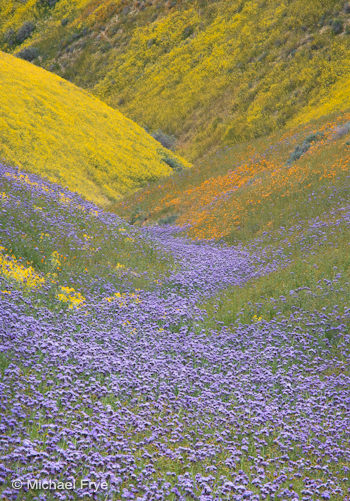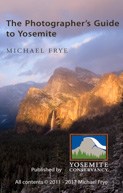Yosemite Photo Conditions
by Michael Frye | Mar 9, 2011 | Yosemite Photo Conditions
Wildflowers in the Temblor Range, Spring 2010
It’s been a strange winter in California. November and December were exceptionally wet, January and early February were almost completely dry, then we finally got some rain again in late February and the beginning of March. Now the weather has turned warm and dry once more, bringing thoughts of spring, and wildflowers.
Most of the best wildflower areas in Southern California received above average rainfall, as you can see from this NOAA map. But that six-week dry spell at the beginning of the year may have thrown many of the plants off their rhythm, so it’s difficult to predict what kind of wildflower season it might be. It seems likely that somewhere, sometime, we’ll see some great blooms—but where, and when?
The best I can tell you at this point is to look and listen for the wildflower reports as they come in. While Carol Leigh has discontinued her California Wildflower Hotsheet, she still administers the CalPhoto group on Yahoo, which is always a good resource for wildflower reports. Kahlee Brighton has also started listing flower sightings at the Wildflower Conservancy.
DesertUSA is another valuable site, with wildflower reports for Arizona, Nevada, New Mexico, and Texas as well as California. Also check out the Theodore Payne Foundation’s Wildflower Hotline. Sandy Steinman has a comprehensive list of links to wildflower reports on his blog.
These links just scratch the surface of what’s available, so if you know of other good sources please feel free to post them in the comments. And of course I’ll keep you up to date on what’s happening around the Yosemite area on this blog. So far, not much!
by Michael Frye | Mar 3, 2011 | Yosemite Photo Conditions
El Capitan and the Merced River, 8:23 this morning
Rain fell on and off since Tuesday night, but skies finally cleared out this afternoon. This morning, before the rain left completely, I got to photograph a beautiful break between squalls, with swirling mist around El Capitan, and sun illuminating the cliff and clouds. It probably looked great from Tunnel View also, and I’d love to see photos from there, or other spots in the valley. If you were in the park this morning, please post links to your photos in the comments!
Another storm is due Sunday and Monday. This next one might be a little colder, so we could see snow at the tail end of it. And forecasters are expecting more wet weather later in the week. This is the best time of year for evening photographs from Tunnel View, when late-day sunlight strikes both El Capitan on the left and Cathedral Rocks on the right. If we’re lucky one of these storms might clear in the afternoon and add some clouds and mist to that balanced light.
by Michael Frye | Feb 17, 2011 | Yosemite Photo Conditions
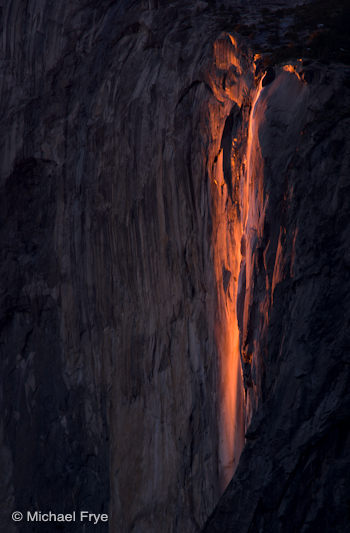 Last Friday I was in Yosemite Valley being interviewed by Steve Bumgardner for a segment of his Yosemite Nature Notes video series. After the interview I decided to head over to the Southside Drive viewpoint for Horsetail Fall. Skies were clear to the west, so the waterfall got that last orange light, but as you can see from this photo there wasn’t a lot of water. It’s a decent flow for this ephemeral fall, better than in some years, but a little below average. Compare the accompanying photo to this one from 2010, or another from 2009. Of course none of these approach the tremendous volume of water in my image from February 1995.
Last Friday I was in Yosemite Valley being interviewed by Steve Bumgardner for a segment of his Yosemite Nature Notes video series. After the interview I decided to head over to the Southside Drive viewpoint for Horsetail Fall. Skies were clear to the west, so the waterfall got that last orange light, but as you can see from this photo there wasn’t a lot of water. It’s a decent flow for this ephemeral fall, better than in some years, but a little below average. Compare the accompanying photo to this one from 2010, or another from 2009. Of course none of these approach the tremendous volume of water in my image from February 1995.
Despite the less-than-spectacular flow, clear skies last weekend allowed many people to capture some nice Horsetail Fall images. You can find links to a few of those photos in the comments of my last post about Horsetail from February 8th.
Meanwhile, a snowstorm deposited about six inches of snow on the valley floor yesterday. Another larger storm is predicted to bring snow tonight through Saturday. We may get a break Sunday or Monday, so Horsetail photos might still be possible again this year. The cold weather has diminished the flow in Horsetail even further, but one warm, sunny day could revive it.
But hey, Horsetail, schmorsetail—we’ve got snow! And clouds, and the chance for clearing storm photos when the next system departs. After six weeks of rather bland skies, it’s nice to see some interesting weather. We could have some great photo opportunities in Yosemite over the next week.
I’ve had a busy workshop schedule, plus a last-minute writing assignment, so I haven’t been able to devote time to the next photo critique, but I should be able to post that next week. I think it will be an interesting one, so stay tuned!
by Michael Frye | Feb 8, 2011 | Yosemite Photo Conditions
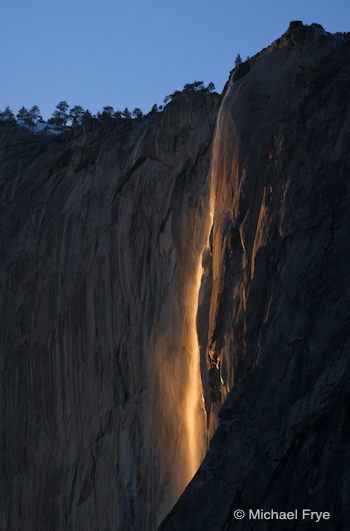
Horsetail Fall, February 22nd, 2010
It’s here—almost. The window of best light on Horsetail Fall will begin around February 12th and continue until approximately February 22nd this year. The big questions is how much water will be in the fall.
Horsetail Fall is fed by snow melting from a small area on top of El Capitan. While there was plenty of snow up there in December, we’ve had only one small storm since January 2nd, and much of that early-winter snowpack has disappeared. Horsetail has a decent flow right now, indicating that there’s still some snow on top of El Cap, and I think there will be enough to last through the window of best light—but it might be a close call. If the snowpack holds up, and the warm, dry weather continues, it could be a banner year for Horsetail Fall photographs, with many clear sunsets.
For more details about photographing Horsetail Fall, see this article on my web site, or previous blog posts here and here. And check out the time-lapse video of Horsetail that Steve Bumgardner just posted.
Meanwhile, Yosemite Falls is still going strong, with exceptionally high flow for February, and excellent early-morning light. That light starts to shift soon—by the end of the month it’s not nearly as good. But for the next week or so the sun will strike the upper fall early, creating golden light on the water, and the chance to see rainbows from the eastern end of Cook’s Meadow.
Just to make things more interesting, there will be a full moon the night of February 17th, right in the middle of the Horsetail window. In Yosemite Valley the best opportunities for moonrise photos occur one to three days before the actual full moon date. I recommend using The Photographer’s Ephemeris to figure out the the specifics, but it looks like the moon might be visible near Half Dome at sunset on the 15th from the eastern end of the valley (Cook’s Meadow and the Ahwahnee Meadow). The evening of the 16th you might be able to see a moonrise from Tunnel View. So if you’re in Yosemite one of those days you’ll have to choose between trying to photograph Horsetail Fall or the moonrise.
If you get any good photographs of Horsetail, a moonrise, or anything else in the park, I’d love to see them, so please feel free to post links in the comments. Good luck!
by Michael Frye | Jan 19, 2011 | Yosemite Photo Conditions
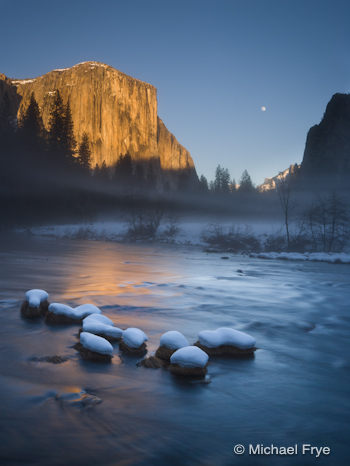
The moon rising between El Capitan and Cathedral Rocks from Valley View
Clear skies have allowed my workshop students and me to photograph the rising moon on three successive days: over Half Dome on Sunday, between El Capitan and Cathedral Rocks on Monday, and between Half Dome and El Capitan from Tunnel View yesterday. Naturally the timing for this workshop (Photoshop and Digital Printing, with The Ansel Adams Gallery) was planned to take advantage of these lunar opportunities, but you never know what kind of weather you’ll get, so we’ve been lucky.
Where November and December were exceptionally wet, January has been dry so far. Yosemite photographers often hope for precipitation and the opportunity to photograph a clearing storm, but every set of conditions creates unique opportunities. The clear, warm weather is melting the abundant snow pack and producing an exceptionally high flow in Yosemite Falls. It looks more like March than January. The light, however, is still at its winter angles, striking the falls shortly after sunrise—much better than in March, when the sun doesn’t reach the waterfall until it’s high in the sky.
With more clear, warm weather in the forecast, the water flow should stay high or even increase, and we could have great opportunities to photograph Yosemite Falls for several weeks.
If you had a chance to photograph the rising moon the last few days, or the high water in Yosemite Falls this winter, I’d love to see the images, so please post a link in the comments.
by Michael Frye | Jan 11, 2011 | Yosemite Photo Conditions
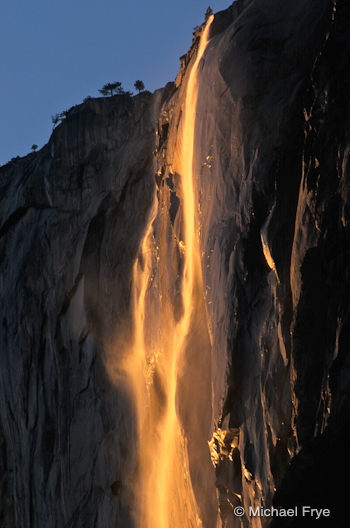
If you’re hoping to photograph Horsetail Fall this February, here’s a post from last year that outlines some of the basics about the timing and best locations. You’ll also find an article on my web site with a detailed description of the factors that go into determining the best dates to photograph this phenomenon.
Since every astronomy program seems to disagree with every other one, it’s hard to figure out exactly what the best dates are each year, but it appears that the window of best light will be a little later this February, from about the 12th to 22nd. Good luck!

